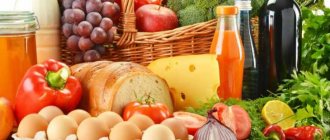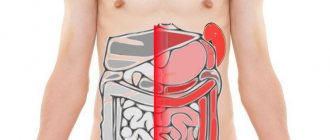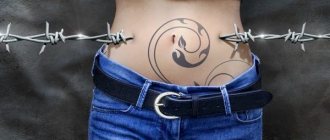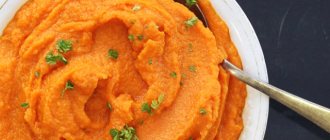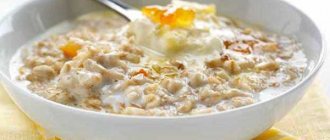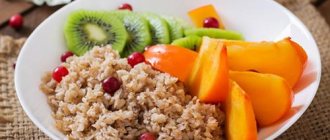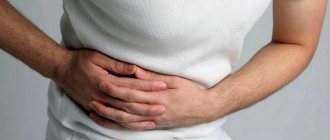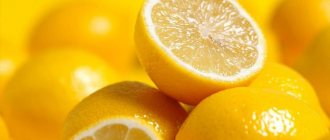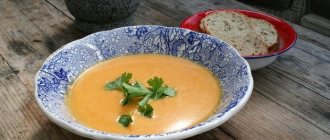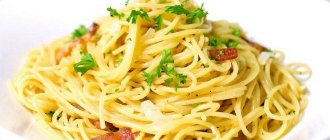13937
Cholecystitis is an inflammatory process in the gallbladder. As a result of this, the patient experiences pain in the right hypochondrium, nausea accompanied by vomiting, the skin changes color to yellow, etc.
Pancreatitis is inflammation of the pancreas. The pathology is accompanied by severe pain on the right side of the abdomen, nausea, and vomiting. With both diseases, body temperature also rises.
Both diseases are closely related. One pathology provokes the occurrence of another and vice versa. For this reason, the diseases have a similar treatment regimen. It is important to follow a diet for cholecystitis and pancreatitis in order to relieve exacerbation, increase the effectiveness of treatment and avoid the disease becoming acute.
Basic principles of nutrition
A diet for pancreatitis and cholecystitis, together with the medications that the patient takes, can significantly improve a person’s condition and reduce the intensity of symptoms. Therefore, the patient needs to know about prohibited and permitted products and adhere to a special regime. The inflammatory process in the pancreas is often combined with pathological changes in the gallbladder, for example, with the formation of stones in this organ. Such ailments develop as a result of poor diet, irregular food intake, and frequent bowel retention. They can occur in people leading a sedentary lifestyle, suffering from infectious diseases, as well as in expectant mothers. Additional factors that increase the likelihood of pathologies occurring are stressful situations, abuse of fatty foods, meat dishes and alcoholic beverages.
The basic rules of the diet for pancreatitis and cholecystitis are as follows:
- The diet should be frequent and fractional. Patients are recommended to eat five to six times a day, in small portions. You should consume no more than 3.5 kg of food and about 2.5 liters of liquid per day.
- The basis of the diet of patients is proteins. The amount of carbohydrates and lipids should be limited.
- Dishes need to be boiled or steamed.
- Smoked, fried and salted foods, fatty foods and strong broths are prohibited.
- Soups should be prepared using water.
- The patient's diet should contain low-lipid dairy products, unsweetened fruits, lean meat, fish and poultry, vegetables, eggs (up to two per week).
- Vegetable oil is consumed only in its pure form.
- The amount of granulated sugar should be reduced to 70 g per day.
- Fresh bread is replaced with stale bread. Products made from butter dough are not recommended.
- Butter is allowed in small quantities (up to 20 g per day).
- You should completely avoid canned foods, hot sauces, spices, cocoa and chocolate.
- Foods containing eggplants and mushrooms are not recommended. Cabbage, legumes and other foods that cause increased formation of gases in the intestines are prohibited.
- Dishes should not be hard. You should eat chopped foods. It is recommended to make puree from fruits and vegetables. Pureed foods should not be eaten for a long time. Therefore, this aspect of the diet should be discussed with a specialist.
- Nutrition should be balanced. The patient must consume at least 200 g of proteins, 50 g of lipids and 350 g of carbohydrates per day.
Complications of gallstone disease
Many patients postpone surgery for personal reasons, mainly due to the fear of complications after the operation and the procedure.
This is because all of them are familiar with the complications if stones are left in the gallbladder. Gallstone disease refers not only to the accumulation of stones in the bladder, but also in its ducts. This condition is observed in a third of the adult population, which indicates the widespread prevalence of the disease.
The presence of stones provokes inflammation of the organ tissue, which is characterized in medicine as calculous cholecystitis. Its difference from acalculous cholecystitis is precisely the presence of stones.
An inflamed gallbladder becomes a source of infectious diseases in the body. Possible complications of stones deposited in the bladder:
- Transition of the disease into a purulent form;
- Jaundice;
- Biliary pancreatitis – observed in 87% of patients with gallstones;
- Lesions of the stomach and duodenum;
- Sphincter of Oddi dysfunction;
- Intoxication of the body.
Diet during exacerbation
If the patient's condition worsens, fasting is recommended. For two days a person drinks only still water (up to 2 liters per day). Then the diet can be gradually expanded. On the third day, the diet for exacerbation of pancreatitis and cholecystitis involves the use of liquid dishes.
Until the end of the exacerbation period, it is necessary to completely abandon raw vegetables and fruits, any confectionery products with added fat, and egg yolks. Other products prohibited by table 5 are also excluded.
After operation
There is a common misconception among patients with pancreatitis and cholecystitis that after the bladder is removed, the pancreas takes over all its functions. But that's not true.
If pancreatitis appears precisely because of the accumulation of stones in the bladder, then its removal can lead to stable remission or complete recovery. If the disease was not advanced and the stones were removed on time, a complete recovery is possible.
In more than half of patients, pancreatic juice secretion returns to normal after surgery. If the operation was performed with some errors, or there were already serious complications, symptoms of postcholecystectomy may develop. They usually occur in the background:
- Liver dysfunction;
- Dysfunction of neighboring organs after removal;
- Errors in surgical intervention or tactics;
- Restructuring the digestive system taking into account the changes made;
- Formation of a new pathology as a complication after surgery.
Main rules
The diet for exacerbation of pancreatitis and cholecystitis should include only those foods that are easily absorbed by the body. You need to eat soft, crushed food. You can include in your diet cereal dishes cooked in milk (if there is no intolerance), in water or in vegetable broth. We recommend pureed soups without adding meat, low-fat cottage cheese (in the form of soufflés, casseroles).
As your condition improves, you can expand your diet. It includes chopped meat, fish and boiled vegetables (in the form of pates).
In the first two days of the diet for acute pancreatitis and cholecystitis, food is prepared without adding salt to reduce the intensity of the outflow of bile. The daily diet should include from 50 to 60 g of lipids, no more than 90 g of proteins and 180-210 g of carbohydrates. Food should not contain seasonings. The optimal temperature for food is 50 degrees. Too hot or cold foods have a harmful effect on the gastrointestinal tract.
Cholecystitis and exacerbation of pancreatitis: what can you eat?
Exacerbation of cholecystitis and pancreatitis is accompanied by pain and dyspeptic symptoms. During this period, active drug therapy is carried out, and fasting and rest are recommended for the first days. Eating restrictions, depending on the severity of the patient’s condition, may be prescribed for 3 to 5 days. Treatment is carried out in a hospital, and if vomiting and diarrhea are moderate, drinking is prescribed:
- non-carbonated alkaline mineral water (Borjomi, Smirnovskaya, Slavyanovskaya);
- rosehip decoction;
- fruit compote;
- jelly;
- Not strong brewed tea.
Nutrition is carried out parenterally - intravenous administration of nutrient solutions, which are selected for each patient individually.
From the 5th day, it is allowed to eat a small amount of food within the limits of table No. 5p - pureed option: all food must be grated until it has the consistency of a puree or a mushy appearance. The essence of the diet: minimize the irritating chemical, mechanical and thermal effects of food on the gastric mucosa and affected organs. The menu includes: permitted vegetable, pureed millet soup, porridge (rice, buckwheat, oatmeal and semolina). Vegetables are recommended boiled, in small portions:
- beet;
- zucchini;
- carrot;
- potato.
Gradually the diet expands, allowing:
- lean meat and fish;
- egg whites;
- low-fat fermented milk products.
Goat cheese - feta cheese is especially useful: a minimum of fat, soft consistency, two-month aging, and easy digestion make it a useful dietary product for cholecystopancreatitis. It does not cause increased production of gastric juice, which is important for patients with this pathology. A good review from nutritionists allows it to be widely used in the menu: the elderly or children are not an exception.
Expanding your diet as your condition improves
When the signs of inflammation become less pronounced, the diet during exacerbation of chronic pancreatitis and cholecystitis can be made more varied. It contains dairy products with low lipid content (yogurt, unsweetened yogurt, kefir), which should be drunk often, but in small portions. In addition, the patient is allowed dishes from lean meat, fish, vegetables, juices from non-acidic fruits and berries. Food should contain a minimum amount of granulated sugar and salt. Products containing coarse fiber, desserts, and spices are prohibited. Food is taken five to six times a day, chewed thoroughly. You should adhere to a clear regimen, try to eat at the same time. Dishes should not be too cold or hot. Food should be baked in the oven without oil, boiled or steamed. Fried, spicy, pickled, fatty and salty foods should be avoided. You should exclude foods that provoke stool retention, increased production of bile and pancreatic juice. This diet must be followed for several months. Sometimes the doctor prescribes a diet for a year.
Gallbladder removal
Removal is prescribed mainly when a large number of stones are detected that interfere with the functioning of the gallbladder and its ducts, and also cause organic dysfunction of neighboring organs.
If the stones are accompanied by a secondary disease, for example, very often accompanied by pancreatitis, the decision to remove them is made almost categorically. The fact is that the accumulation of stones will obstruct the flow of bile, and it will penetrate into the channels of the pancreas, essentially leading to its self-digestion. This condition is dangerous not only by inflammation of the gland tissue, but also by pancreatic necrosis - the organic death of pancreatic cells without the possibility of restoring their function.
Approximate diet
Seven days after the disappearance of acute symptoms, the patient’s diet becomes quite varied. It includes:
- Wheat bread crackers.
- Dishes made from buckwheat, semolina and oatmeal.
- Soups with a slimy texture.
- Kissels made from fruits and berries.
- Lean cutlets made from beef and chicken.
- Boiled lean fish.
- Drink made from rose hips.
- Crushed potatoes.
- Weakly brewed tea (black or green).
- Steamed egg white omelette.
- Baked apples.
- Carrot puree.
- Steamed cheesecakes or cottage cheese casserole.
The diet menu for exacerbation of pancreatitis and cholecystitis may look like this.
Breakfast consists of a protein omelet with steamed tomatoes and rosehip infusion. After a few hours, you can eat some low-fat cheese and a glass of carrot juice. For lunch, a fish cutlet and crushed potatoes, boiled beets, and compote are offered. Cottage cheese casserole is allowed for afternoon tea. For dinner - steamed vegetables with lean chicken, weakly brewed tea.
Below is another sample diet menu for pancreaticholecystitis (in the acute stage). For breakfast, we offer semolina porridge, a milk shake with muesli and banana. After a few hours, you can eat low-fat cottage cheese with sour cream and berries. For lunch, rice soup, meat casserole, and a glass of compote are allowed. For an afternoon snack - grated carrot salad. For dinner, chicken meatballs, steamed vegetables, and weakly brewed tea are offered.
Postoperative period
Treatment in the postoperative period consists, first of all, of following a proper diet. This is how you can avoid exacerbations of pancreatitis.
This phenomenon reduces the resistance of organs and causes inflammatory foci in the pancreas, which is called pancreatitis. In addition, a disorder of the intestinal microflora can lead to constipation and diarrhea.
To prevent inflammation, the patient is prescribed diet number five according to Pevzner, with adjustments by the gastroenterologist if necessary. The basic rules of this diet are as follows:
- Fractional meals in small portions;
- Increased number of small meals - up to six, seven times a day;
- Limiting fatty and spicy foods;
- Limiting pickles, canning - both homemade and store-bought, in particular;
- Preference is given to boiled, stewed and baked foods;
- The food should be served neither hot nor cold, the temperature should be slightly above room temperature;
- Products that cause fermentation processes in the intestines are excluded: baked goods and rye products, confectionery, pickles, apples, cabbage;
- Products made with preservatives, substitutes, dyes, flavors, and flavor enhancers are excluded.
Nutrition for chronic pathology
In this case, a less strict diet for pancreatitis and cholecystitis is possible. The pancreas suffers from excess glucose. You should reduce the amount of fast carbohydrates in your diet. The patient needs to give up granulated sugar, honey, and confectionery. Salt can be used in cooking, but in small quantities. Alcohol and tobacco products are prohibited. Spices, hot sauces, and vinegar are contraindicated for patients.
What diet for pancreatitis and cholecystitis is recommended for patients? People with this form of pathology are prescribed the 5p table. The daily energy value of the diet is 2690 kilocalories. Dishes should be stewed, baked in the oven, boiled, steamed. If your condition improves significantly, you can adjust your diet. But before expanding the menu, the patient should consult a doctor.
Diet for pancreatitis in children
In young patients, the disease often occurs secretly: hiding behind other diagnoses. For this reason, treatment sometimes cannot begin immediately. If symptoms are detected, the child is referred to a pediatric gastroenterologist. It is very important to prevent the disease from becoming chronic. And this is only possible with strict adherence to the doctor’s instructions and a therapeutic diet. The causes of the disease in childhood are different: from overeating and irregular diet to past viral diseases and damage to the gastrointestinal tract. However, regardless of the cause, a small patient needs a selected therapeutic diet.
The baby's diet must contain all the nutrients necessary for growth and development. It is difficult to give up sweets, favorite foods and usual diet, but you should distract your child by playing, reading or talking. It is imperative to survive this difficult period without disruptions in nutrition. Then the little patient will become healthy again in the shortest possible time.
Authorized Products
A diet for cholecystopancreatitis may include:
- Lean meat (veal, rabbit, beef), lean poultry (chicken, turkey). It is recommended to steam these dishes.
- Dried or yesterday's bread made from wheat flour (possibly with bran or grains). Biscuits, baked pies with curd, fruit, meat or fish filling.
- Non-acidic dairy products with a fat content of no more than 3.5%.
- Butter and sour cream (they need to be added to dishes).
- First meal. Patients are allowed soups based on milk, vegetables (without frying), and lean meat broth.
- Low-fat varieties of fish (pike perch, hake, pike, cod), seafood.
- Refined vegetable oil (no more than two large spoons per day). Allowed during remission.
- Dishes made from oatmeal, buckwheat, rice and semolina, small pasta.
- Mild and unsalted cheeses with low fat content.
- Vegetables and herbs (consumed only after heat treatment).
- Berries and fruits with a non-acidic taste (not raw), dried fruits.
- Eggs (no more than one per day in the form of a steamed egg white omelet).
- A small amount of sweets. Marshmallows, marshmallows, jellies and mousses, marmalade, honey, caramel, non-sour jam, meringue, sweeteners are allowed.
- A decoction of herbs (mint, chamomile), a drink made from rose hips, weakly brewed tea and coffee with added milk.
- Kissel, compote, non-acidic juices and fruit drinks, diluted with water.
Diet during remission of the disease
During the period of remission of cholecystopancreatitis, table No. 5B is prescribed - it is considered as a type of diet No. 5p. Designed for:
- for patients in remission of the disease,
- to prevent relapses and progression of the inflammatory process,
- correction of emerging nutritional disorders.
- grinding food,
- temperature regime (food is warm, comfortable temperature),
- fractional intake (often in small portions),
- gentle cooking - stewing in steam, water.
Table 5B is considered a diet of increased energy value. It increases the content:
- proteins (up to 110 g),
- fats - the allowed amount is brought to the lower limit of the norm (20% of them must be vegetable), introduced gradually,
- carbohydrates - 350–400 g, but simple carbohydrates are still limited to 30 g per day.
- pureed vegetable and milk soups with the addition of cream and milk,
- yesterday's wheat bread and biscuits,
- lean meat,
- lactic acid products, low-fat or low-fat; milk, due to poor tolerance, is added to dishes - cereals, soups, omelettes,
- vegetables - boiled,
- apples - baked, jam, jelly.
- spicy seasonings,
- extractives,
- strong broths,
- smoked meats,
- salo,
- fresh white cabbage,
- alcohol, coffee, chocolate, strong tea.
Permitted and prohibited products are specified using special tables.
Sample menu for the week
When compiling a diet, the whole week is planned out: the presence and amount of proteins, fats and carbohydrates in the menu are calculated using special tables. Meals are provided six times a day, including snacks - second breakfast and afternoon snack.
Sample menu for one day:
- Breakfast: oatmeal on water with jam, crackers, weak tea.
- Second breakfast: apple baked with cottage cheese, compote.
- Lunch: rice soup, boiled chicken breast, boiled beets in the form of a salad, seasoned with vegetable oil, rosehip infusion.
- Afternoon snack: a portion of noodles with cheese, dried fruit compote.
- Dinner: a glass of kefir.
The menu for the week is prepared in a similar way, using recommended products. Tables indicating caloric value and a list of permitted foods are used.
Prohibited Products
The diet menu for pancreatitis and cholecystitis excludes the following foods:
- Fresh bread, muffins, sweet pastries, fried pies, pancakes and pancakes.
- Strong broths from meat, fish, poultry, mushroom soup, cabbage soup and okroshka.
- Smoked and canned foods, pickled and salted dishes.
- Offal.
- Fatty varieties of meat (pork, lamb), fish (salmon, mackerel), poultry (duck, goose), lard, caviar, bacon.
- Sausages, pates, sausages and sausages.
- Fast food, convenience foods, chips and other types of snacks.
- Spices, vinegar, hot sauces (ketchup, mayonnaise, adjika, horseradish, mustard).
- Vegetables containing coarse fiber (white cabbage, radishes, turnips, spinach, legumes).
- Sorrel, garlic, rhubarb, onion greens.
- Sour fruits and berries.
- Confectionery with cream and large amounts of granulated sugar, desserts containing preservatives and dyes, chocolate, cocoa, ice cream.
- Strongly brewed tea, black coffee, any alcoholic beverages, soda.
- Sour juices.
Each patient should strictly adhere to the restrictions provided by the diet for pancreatitis and cholecystitis. The pancreas and gallbladder are very sensitive to any changes in diet. Compliance with the rules allows you to avoid deterioration in well-being.
Effect on the pancreas
The gallbladder is small and resembles a pouch located under the liver. The exit from the gallbladder is a sphincter that blocks the erratic flow of bile.
The organ is designed to accumulate and store bile, and then remove it into the gastrointestinal tract when necessary. As for the pancreas, it secretes pancreatic juice, which is responsible for the digestion of food. In addition, the gland secretes insulin and glucagon, which are necessary to correct the concentration of sugar in the blood.
The bile and pancreatic ducts enter the duodenum through the sphincter of Oddi. This becomes the decisive factor in the detection of biliary pancreatitis. If there are stones in the gallbladder, even the smallest stones brought to the sphincter of Oddi block its lumen, causing reverse flow of bile and congestion in the pancreas.
Menu samples
An example of a diet for chronic pancreatitis and cholecystitis may look like this. For breakfast, oatmeal porridge cooked in water, steamed egg white omelette, and weakly brewed tea are offered. After a few hours, unsalted low-fat cheese and goat's milk are allowed. The daily meal consists of buckwheat soup, vegetable stew with boiled beef, apple jelly, compote. For afternoon tea, baked pear and weak tea are allowed. For dinner, we offer carrot puree, steamed fish balls, and a rosehip drink. Before going to bed, you can eat cottage cheese soufflé and drink a glass of low-fat yogurt.
When describing the diet, we always talk about a single diet for pancreatitis and cholecystitis. The gallbladder, like the pancreas, plays an important role in digestion. Cholecystitis often accompanies inflammation of the pancreas, so in medical practice the same diet is prescribed for these ailments. A sample of another sample menu on it is presented below. The morning meal consists of pureed oatmeal cooked in milk, a steamed protein omelet, and weakly brewed tea. After a few hours, crushed potatoes with added butter and a drink made from rose hips are allowed. For lunch, vegetarian soup, steamed meatballs made from lean chicken, and sweet fruit jelly are offered. For an afternoon snack – baked apples with added granulated sugar, compote. Dinner consists of cottage cheese casserole and weakly brewed tea. Before going to bed, jelly made from berries or fruits is offered.
Principles of an effective diet
To slow down the development of diseases of the gallbladder and pancreas, doctors advise their patients to adhere to an effective therapeutic diet, which is called table No. 5. Knowing what you can eat with cholecystitis and pancreatitis is necessary, first of all, in order to learn how to relieve the affected organs. With such diseases, they lose the ability to act harmoniously, but you can get rid of pain and discomfort on your own.
Dietary table No. 5 involves following several key rules.
- Regular meals, which consist of three full meals and several light snacks. Fasting and overeating should be avoided.
- You need to eat in small portions, which will be enough to not feel hungry. But at the same time they should not be high in calories.
- It is equally important to control the temperature of the food consumed. You should avoid overly hot and cold treats. Ideally, products should have a temperature of about 40 degrees.
- The foods consumed should not burden the digestive tract. It is worth giving up fibrous foods that contain a lot of fiber. During the cooking process, it is advisable to chop and grind all products to facilitate the functioning of damaged organs.
- Dishes can be prepared in a steamer, oven, or simply boiled, but under no circumstances should they be fried.
- Egg consumption should be reduced to 2-3 per week, and it is advisable to eat only the whites.
- The amount of coffee and tea in your diet should be limited, and alcohol should be completely avoided.
This diet is always recommended during remission.
Dish recipes
Following a diet for cholecystopancreatitis does not mean that the patient needs to eat tasteless food. There are many options for preparing mouth-watering dishes. One of them is pumpkin soup. For it you will need the following products:
- Milk in the amount of 0.7 l.
- Approximately 200 g of bread.
- At least 100 ml of cream.
- Pumpkin pulp in the amount of 600 g.
- Approximately 75 g butter.
- Salt.
The recipe looks like this.
The pumpkin pulp is divided into cubes. Boil in milk. The bread should be sliced and dried in the oven. Add to the soup and cook until the mixture has a soft texture. If the dish is too thick, you can add a little more milk. The soup should be slightly salted. Add cream and butter to the dish.
As a second course, you can prepare cutlets from apples and carrots. This is a healthy dish that contains many vitamins. Recipe includes:
- Two large spoons of granulated sugar.
- Egg.
- Breadcrumbs.
- Two sweet apples.
- Large carrots.
- Three tablespoons of semolina.
- 50 ml boiling water.
Carrots should be washed, peeled, and divided into thin oblong pieces. Cover with granulated sugar. Add boiling water. Boil the mixture until it becomes soft. Place peeled and chopped apples into it. Simmer the mixture for five minutes, remove from the stove. Add semolina, egg white. Grind the ingredients well. Form them into balls. Roll the products in breadcrumbs. The cutlets should be cooked in the oven for a quarter of an hour. It is recommended to serve the dish with sour cream.
For people suffering from pancreatitis and cholecystitis, a dish such as an omelet cooked in a steamer with potatoes is perfect. For it you will need:
- Approximately 100 ml of milk.
- 50 g hard cheese.
- About 200 g of boiled potatoes.
- Eggs (at least four pieces).
- Table salt.
- Greenery.
The potatoes are crushed using a grater. The eggs are broken in a separate plate. Add milk and table salt. Mix the ingredients thoroughly. The steamer bowl is covered with food grade film. Place a layer of potatoes on the surface of the vessel. Fill it with a mixture of eggs and milk. Sprinkle the food with chopped herbs. Cook the omelet in a double boiler for about thirty minutes.
Vegetarian pilaf is perfect as a second vegetable dish. The meal includes:
- A glass of rice cereal.
- Onion head.
- Zucchini.
- Two medium sized carrots.
- One tomato.
- Table salt.
- Greenery.
- Vegetable oil.
Vegetables should be washed and cut into small cubes. The skin is first removed from the surface of the zucchini. The carrots are chopped using a grater. Vegetables are stewed in a frying pan with a small amount of vegetable oil. Add raw rice cereal. Mix the ingredients and add lightly salted water. The liquid should cover the grains by about two to three centimeters. The dish is brought to a boil. Cook covered, without stirring, until the rice grains become soft. The finished dish is served with chopped herbs.
